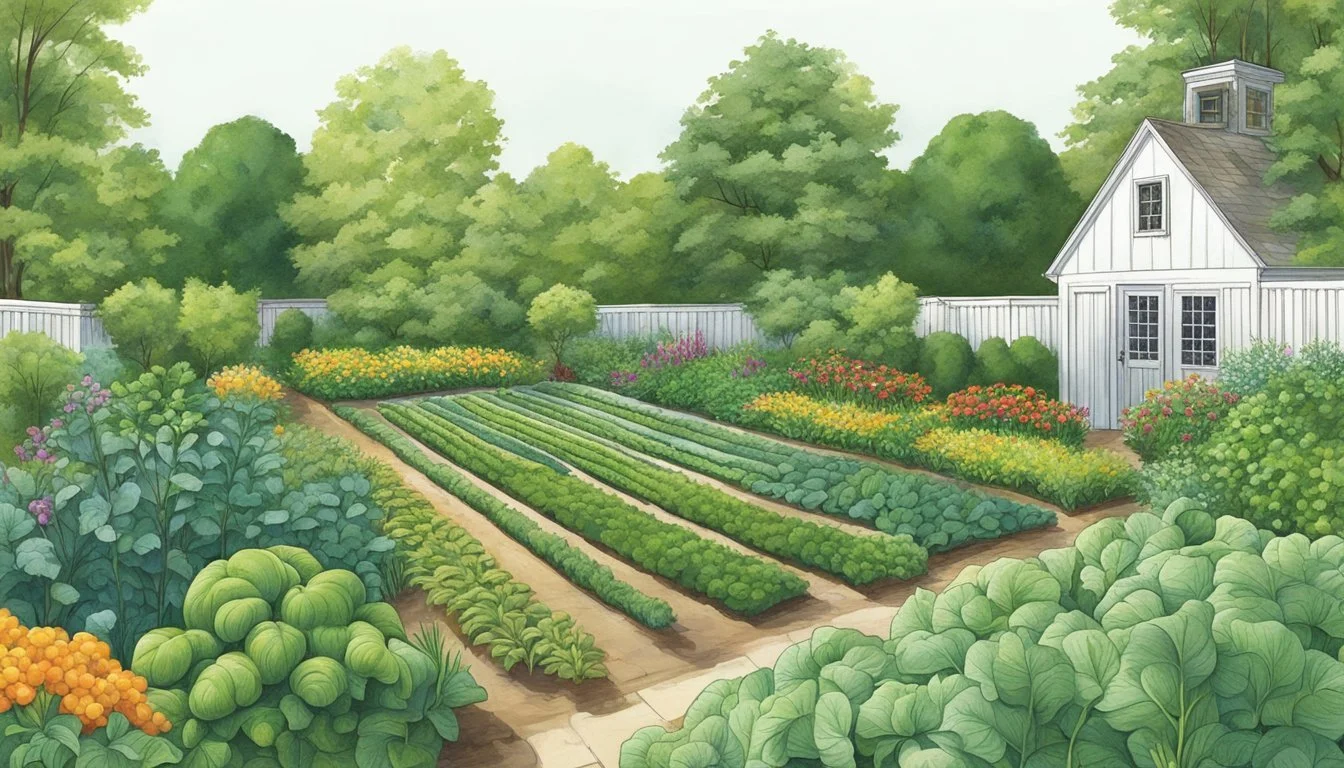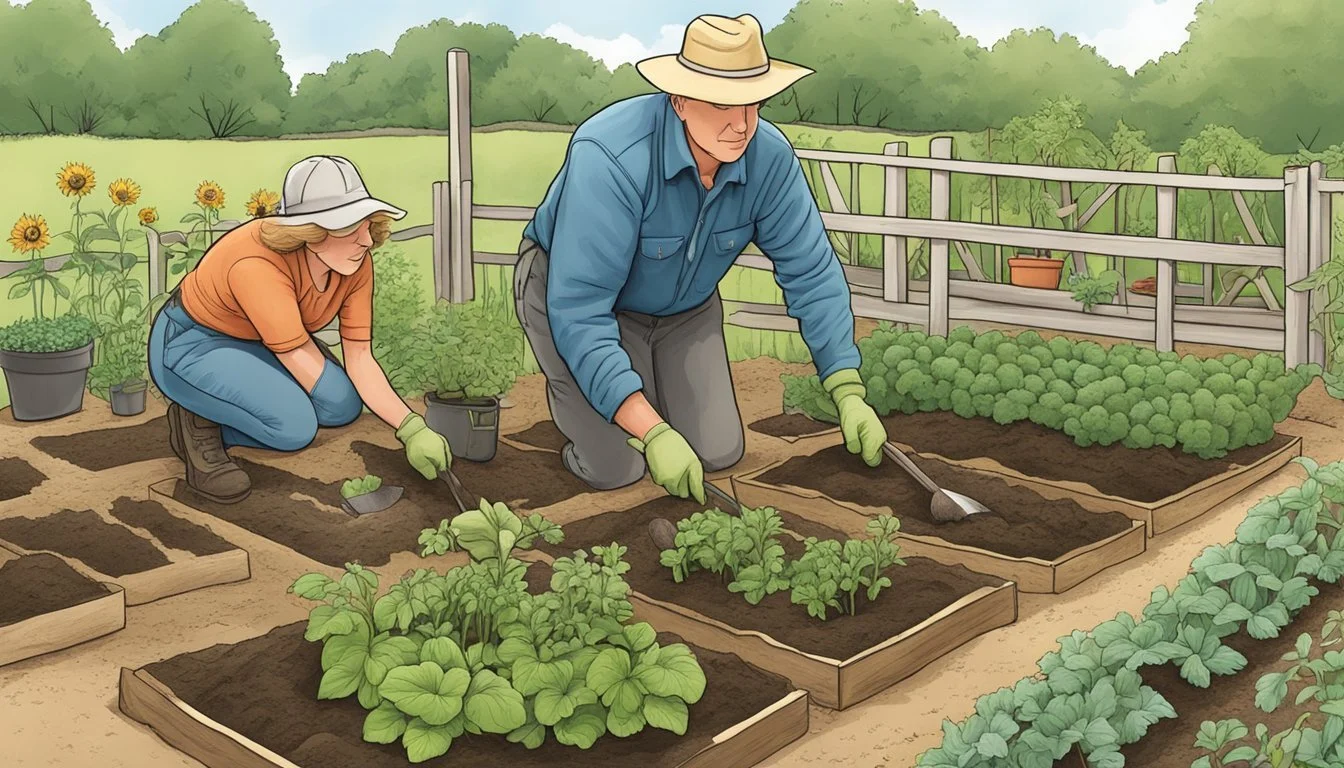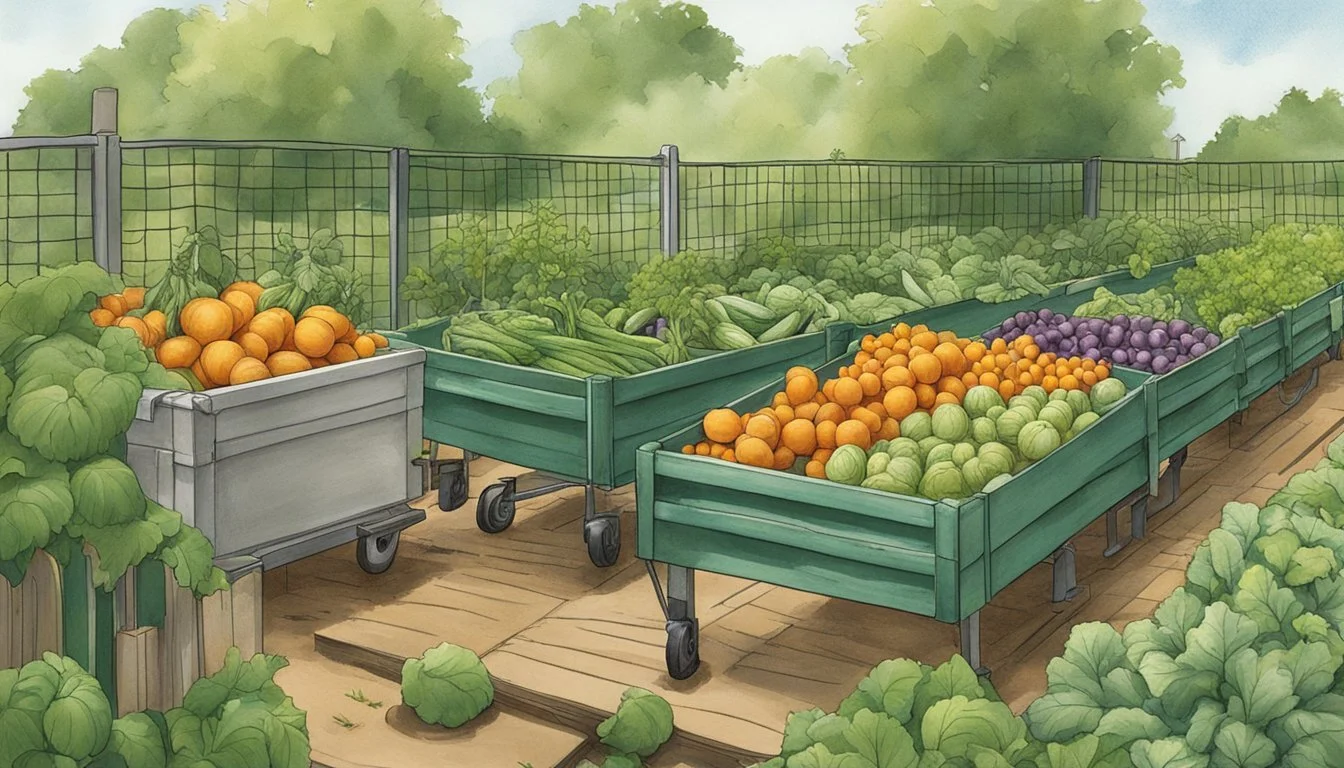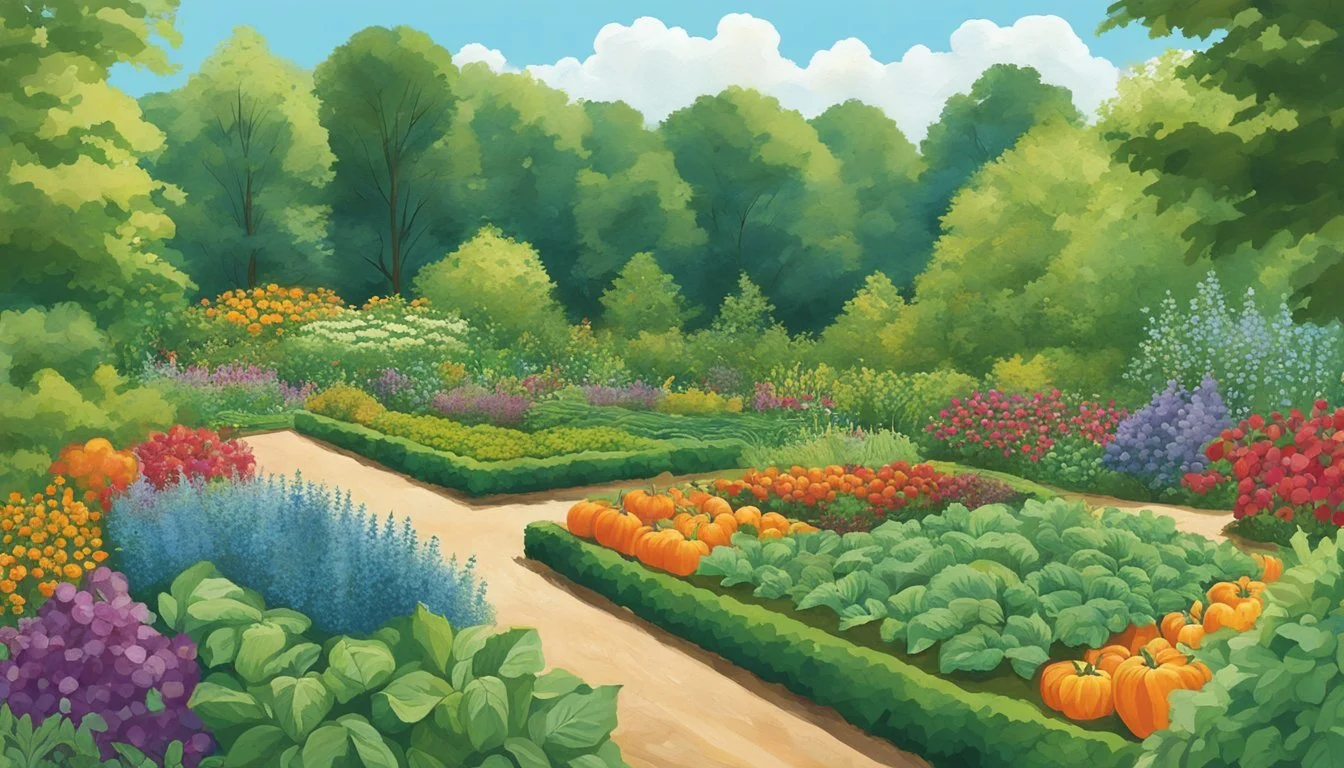Vegetable Gardening in Connecticut
A Guide to Thriving Gardens in the Nutmeg State
This Article is Part of Our Guide on Vegetable Gardening by State
Vegetable gardening in Connecticut offers an abundance of opportunities for residents to cultivate a variety of produce suited to the state's seasonal climate. With cold winters and warm summers, gardeners in Connecticut can plan their planting schedules to make the most of the frost-free growing season, which varies across the USDA plant hardiness zones 5-7 found in the region. Hearty greens such as spinach and Swiss chard, leafy vegetables including cabbage and lettuce, and other staples like tomatoes, carrots, and beans thrive in Connecticut's soil, which can vary in composition from one area to another.
Gardeners in Connecticut typically begin their planting journey with cold-hardy vegetables like lettuce, which can withstand the cooler temperatures of early spring and fall, often surviving frost and even light snow. As the season progresses and the frost dates subside, the planting of root vegetables and fruiting crops such as tomatoes, eggplant (What wine goes well with eggplant?), and squash becomes prominent. Careful attention to timing is essential, as is knowledge of the last and first frost dates, which play a critical role in determining the planting schedules for various crops.
Maintaining a vegetable garden in Connecticut is not only a rewarding hobby but also contributes to the local food supply, promoting sustainability and self-sufficiency. Low-maintenance requirements of certain crops and the possibility of year-round gardening, given the proper preparations for winter, allow for a continuous harvest. Whether a novice or experienced, gardeners can enjoy the fruits of their labor with an understanding of the state's gardening landscape and the patience to see their vegetables grow through the seasons.
Understanding Connecticut's Climate for Gardening
Connecticut's climate, with its distinct seasons, impacts what gardeners can grow and when. The state sees cold winters and warm summers, which directly influence planting times and the choice of crops.
Climate Overview
Connecticut experiences a variable climate with a mix of cold winters and warm summers. Winter temperatures can drop significantly, while summer brings higher temperatures that can benefit certain crops. This variation defines the state's gardening calendar, necessitating a strategic approach to planting and harvesting.
Hardiness Zones
Connecticut encompasses several USDA hardiness zones:
Zone 5: Characterized by colder extended winters.
Zone 6: Offering a moderately cold winter.
Zone 7: Experiencing milder winters than the rest.
Each zone has implications for the start and end of the growing season and the types of plants that can thrive there.
Connecticut Hardiness Zones
Zone Average Minimum Winter Temperature Suitable Plants 5 -20 to -10°F Cold-hardy perennials, root vegetables 6 -10 to 0°F Broader variety including many annuals 7 0 to 10°F Warm-season crops, longer growing season
Sun Exposure and Shade
Gardeners must also consider the amount of sun and shade their gardens receive. Most vegetables require at least six hours of direct sunlight daily. Locations in Connecticut can provide ample sunlight during the growing season, but gardeners should observe their specific site's exposure to ensure adequate light for their chosen crops. Areas of the garden that receive less light can be reserved for crops that tolerate or thrive in partial shade.
Planning Your Vegetable Garden
Effective vegetable gardening in Connecticut begins with well-conceived plans that address the layout and selection of vegetables. These initial steps are crucial for maximizing yield and enjoying a successful harvest season.
Garden Layout
When planning a garden layout, proper spacing is essential. One must allow enough room between rows for easy access and growth, considering mature plant sizes. Raised beds or in-ground plots can both be successful, and the orientation should ensure ample sunlight. It's advisable to position taller plants towards the north to prevent shading of shorter crops.
Example Garden Layout:
Row Plants Spacing Between Plants 1 Tomatoes 18-24 inches 2 Peppers 12-18 inches 3 Leafy Greens 6-12 inches 4 Root Vegetables 4-8 inches 5 Cucumbers 36-48 inches
Choosing the Right Vegetables
Selecting the best vegetables to grow in Connecticut is pivotal. One should opt for varieties known to thrive in the state's climate. In Connecticut, cool-season crops like lettuce, spinach, and kale can be planted early in spring. Hearty root vegetables such as carrots, beets, and turnips also perform well. For summer, heat-loving vegetables like tomatoes, eggplant, peppers, and cucumbers are ideal. Beans, squash, and sweet corn are excellent choices too.
Recommended Vegetables:
Spring: Lettuce, Kale, Spinach, Radishes
Summer: Tomatoes, Eggplant, Peppers, Cucumbers
Fall: Carrots, Beets, Collard Greens (how long do collard greens last?), Acorn Squash
When selecting varieties, consider disease resistance and time to maturity. It's also worth incorporating continuous planting methods, such as succession planting, to ensure a steady supply of vegetables throughout the growing season.
Soil Preparation and Management
Proper soil preparation is crucial for a successful vegetable garden in Connecticut. It sets the foundation for plant growth and affects everything from water retention to nutrient availability.
Soil Quality
To assess the soil quality, one must examine its depth and texture. Ideally, topsoil should be at least 6 inches deep. This depth supports robust root development and provides sufficient space for vegetables to draw nutrients. Soil texture is also essential; it should be loose and crumbly, which signifies a good balance of sand, silt, and clay.
Maintaining soil quality involves ensuring a consistent supply of organic matter. Gardeners can enrich their soil by incorporating compost, which enhances soil structure and fertility. Connecticut's climate necessitates soil that can manage water effectively, especially during periodic wet and dry spells.
Attribute Ideal Condition Depth At least 6 inches Texture Loamy (balanced mix of components) Organic Matter High concentration (indicated by dark color) Water Retention Sufficient to withstand variable climate
Fertilization and Amendments
Fertilization is the process of adding nutrients to the soil that are essential for plant growth. The primary nutrients are nitrogen (N), phosphorus (P), and potassium (K), commonly referred to as N-P-K. Connecticut gardens often require an N-P-K fertilizer in specific ratios depending on the vegetables grown.
Amendments serve to modify soil characteristics. For optimal vegetable cultivation, it is common to amend soil with organic materials such as compost or well-rotted manure. This not only provides nutrition but also improves microbial activity, which in turn boosts soil health and plant resilience. An annual application of organic matter can significantly improve soil quality and is a practice recommended by experienced Connecticut gardeners.
To fertilize:
Test the soil to determine nutrient needs.
Apply N-P-K based on soil test recommendations.
Use organic or slow-release fertilizers to maintain consistent nutrient levels.
To amend:
Add organic matter annually.
Use amendments like lime or sulfur to adjust pH as necessary.
Ensure any added material is well-incorporated into the soil.
Planting Techniques
Effective planting techniques are crucial for a successful vegetable garden in Connecticut. Understanding when and how to start seeds, transplant seedlings, and direct sow will ensure a robust garden that can thrive in the region's variable climate.
Seed Starting
Seed starting indoors allows gardeners to begin their growing season early. Seeds should be planted in a sterile seed starting mix, ensuring that the soil is moist but not waterlogged before seeds are sown. Containers should have drainage holes and be kept in a warm location with ample light. Timing is key; gardeners should start seeds 5-8 weeks before the last expected frost to ensure seedlings are ready to be transplanted outdoors in the spring.
Transplanting
Transplants should be gradually acclimated to outdoor conditions through a process called "hardening off." This generally takes about 7-10 days before the final transplant. It’s important to prepare the garden soil by adding organic matter and ensuring it is well-aerated. Plant spacing is critical, and following the specific recommendations for each vegetable type will prevent overcrowding. Transplants need to be watered immediately after planting to help settle the soil around the roots.
Direct Sowing
Certain vegetables prefer to be sown directly into the garden soil, such as carrots and beans. Direct sowing should be done after the danger of frost has passed and soil temperature has reached at least 50°F (10°C). Seeds must be sown at appropriate depths, which is often two to three times the width of the seed. Proper spacing is essential for direct-sown seeds as well, and thinning seedlings may be necessary to allow for adequate growth room.
Garden Maintenance
Effective garden maintenance is critical to the success of vegetable gardening in Connecticut. Adequate watering, consistent weed control, and proactive management of pests and diseases can significantly improve the health and yields of your garden.
Watering Methods
Drip Irrigation: By delivering water directly to the root zone, drip irrigation conserves water and targets plant needs. In Connecticut's variable climate, this method reduces evaporation and prevents leaf diseases caused by overhead watering.
Rain Barrels: They collect rainwater which can be used during dry spells. Given Connecticut's mixed weather patterns, capturing rainwater allows gardeners to have an alternative water source ready for their vegetables.
Weed Control
Mulching: Application of organic mulch such as straw or wood chips helps suppress weeds and retain soil moisture. A mulch layer of 2-3 inches is typically effective in preventing weed growth and makes weed removal easier.
Regular Removal: Weekly weeding sessions control the weed population before they can establish or seed. A weeding schedule prevents competition for nutrients and water between vegetables and unwanted plants.
Dealing with Pests and Diseases
Beneficial Insects: Encouraging ladybugs and lacewings helps naturally mitigate aphid outbreaks, which are common in Connecticut gardens. Creating habitats for these insects can serve as a long-term pest management strategy.
Fencing: To protect against deer and rabbits, a fence at least 8 feet high for deer, and a mesh below ground level for rabbits can be necessary.
Organic Sprays: Neem oil and insecticidal soaps effectively control a range of pests, including insects and mites, while minimizing harm to beneficial species.
Disease Prevention: Crop rotation and proper spacing promote air circulation, reducing the risk of fungal and bacterial diseases. Removing infected plants can prevent the spread of disease within the garden.
Harvesting and Storage
Effective harvesting and storage of vegetables are crucial for maintaining the freshness and nutritional value of your garden produce. Proper techniques ensure a longer shelf life and better taste.
Harvesting Tips
Timing: Vegetables should be harvested at the peak of their maturity when they have the best flavor and nutritional content.
Tools: Use sharp, clean tools to cut vegetables, minimizing damage and bruising.
Handling: Be gentle with the produce to avoid bruising; tender vegetables should be especially handled with care.
Morning Harvest: Whenever possible, harvest vegetables early in the morning when they are crisp and full of moisture.
Frequency: Regular harvesting typically encourages more production, especially for crops like beans and zucchini.
Storing Your Vegetables
Temperature and Humidity: Store vegetables in conditions appropriate for their type; some require cool and moist environments while others need dry conditions.
Vegetable Storage Condition Expected Shelf Life Lettuce Cool, moist environment 1-2 weeks Tomatoes Room temperature until ripe 4-7 days Carrots Cool, high humidity 4-5 months
Refrigeration: Most vegetables like leafy greens should be refrigerated, while others such as onions and garlic should be stored at room temperature.
Preparation: Remove excess soil, but do not wash vegetables before storage to avoid mold and rot.
Containers: Use ventilated containers for items that require air flow and airtight containers for high-humidity storage.
Extending the Growing Season
Successful vegetable gardening in Connecticut involves adapting to the cooler climate and using techniques to protect crops from early and late frosts. By effectively extending the growing season, gardeners can enjoy a more abundant harvest.
Protecting Plants from Frost
When the temperature drops near to 32°F (0°C), frost can damage or kill plants. To safeguard their gardens, Connecticut gardeners should monitor local last frost dates and utilize protective measures:
Cold Frames: Structures that trap heat from the sun, providing a microclimate for plants.
Row Covers: Lightweight fabrics placed over plants to protect them from frost without limiting light.
Mulching: Applying straw or leaves around plants to insulate the soil and maintain warmer temperatures.
Fall and Winter Gardening
To maximize the yield from their gardens, gardeners can plant fall crops that thrive in cooler temperatures. These include cool-season vegetables like lettuce, spinach, and kale. Additionally, the following approaches benefit the garden:
Hotbeds: Utilize decomposing organic matter to generate heat, creating an environment for seeds to germinate and grow in the winter months.
Establishing a fall garden timeline:
Task Timing Sowing fall crops Late summer Harvest Before a hard freeze
Adjustment of watering practices to account for reduced evaporation in cooler weather.
State Gardening Resources
For gardeners in Connecticut seeking guidance, the state offers a wealth of resources through its university extension and master gardener programs. These services provide reliable expertise and educational opportunities tailored to the region's unique gardening conditions.
UConn Extension Services
The University of Connecticut (UConn) Extension provides Connecticut gardeners with vital access to a variety of resources, including horticultural advice, soil testing, and educational materials. Their services are designed to help gardeners understand regional climate challenges, soil composition, and the best practices for a successful harvest tailored to the different areas across the state.
Educational Materials: Publications on best gardening practices and regional plant recommendations
Soil Testing: Laboratory analysis to determine soil health and nutrient needs
Master Gardener Programs
The Master Gardener Program, offered through the UConn Extension, equips gardeners with intensive horticulture training and opportunities to partake in community-based gardening projects. Graduates often volunteer in community gardens, schools, and municipal projects, sharing their expertise while fostering a love for gardening.
Horticulture Training: Comprehensive courses on various gardening topics
Community Outreach: Volunteer opportunities and educational workshops for the public
Both services aim to promote sustainable garden practices and help gardeners derive the maximum benefit from their gardens, whether they're cultivating vegetables, flowers, or other plants.
Special Gardening Techniques
In adapting to Connecticut's varying conditions, gardeners benefit from specialized techniques that maximize yield and ease of management. Techniques such as container gardening, raised bed gardening, and companion planting are instrumental in achieving a successful harvest.
Container Gardening
Container gardening is a versatile and low-maintenance option suitable for those with limited space or soil issues. Gardeners can control soil quality and moisture levels with greater precision, and it's an easy to grow method for a vast array of vegetables. Containers can range from pots to larger planters, and they must provide adequate drainage.
Suitable vegetables for container gardening include:
Tomatoes
Peppers
Leafy greens like lettuce and spinach
Radishes
Herbs
Raised Bed Gardening
Raised bed gardening offers improved soil drainage and creates a barrier against pests and weeds. This technique is great for areas with poor native soil quality and can help to extend the growing season, as the soil in raised beds warms faster in the spring. Raised beds should be constructed with untreated wood to avoid any unwanted chemicals leaching into the soil.
Advantages of raised bed gardening:
Better drainage
Easier on the gardener's back
Potentially higher yields per square foot
Companion Planting
Companion planting involves the strategic placement of certain plants near each other to deter pests, attract beneficial insects, or enhance growth. This practice not only helps to optimize the use of garden space but can also improve the overall health and productivity of the garden.
Examples of companion planting:
Marigolds planted near tomatoes to repel nematodes
Basil alongside lettuce to encourage growth
Carrots sown with radishes, where radishes deter carrot flies
Innovative Practices for Connecticut Gardening
In Connecticut, innovative gardening practices are shaping the future of sustainable food supply. These techniques emphasize eco-friendly methods and the cultivation of nutritionally rich produce.
Organic Practices
Gardeners in Connecticut are increasingly adopting organic practices to enhance soil vitality and protect the ecosystem. Composting and the use of organic mulches are essential to maintain soil health, while natural pest control methods, such as beneficial insects and companion planting, help to reduce the reliance on chemical pesticides. Organic practices also include the use of heirloom seeds and the avoidance of genetically modified organisms, ensuring that the food supply remains pure and unadulterated.
Heirloom Varieties
Heirloom vegetables are coveted for their rich flavors and genetic diversity, which contribute to a more resilient local food system. Connecticut gardeners often choose:
Tomatoes: Brandywine, Mortgage Lifter
Peppers: California Wonder, Purple Beauty
Squash: Waltham Butternut, Blue Hubbard
By selecting heirloom varieties, they promote biodiversity and sustainability, and these vegetables often display better pest and disease resistance adapted to the Connecticut climate.
Hydroponics
Hydroponic systems represent a leap in Connecticut's agricultural practices, enabling year-round vegetable production regardless of outdoor conditions. They use water-soluble nutrient solutions to feed plants, which are grown without soil. This method significantly conserves water and space, granting higher yields and reducing the gardeners' carbon footprint. Connecticut's hydroponic ventures often grow leafy greens, herbs, and tomatoes, thereby bolstering the local food supply with fresh, nutritious produce even during the harsh New England winters.
Landscaping with Edibles
In Connecticut gardens, incorporating edibles into landscaping merges aesthetics with functionality. This approach not only enhances the scenery but also provides fresh produce, catering to both the senses and the dinner table.
Aesthetic and Functional Planting
Landscaping with edibles in Connecticut often involves integrating both perennial and annual edibles with ornamental plants. Perennial plants like berry bushes offer both beauty and yield year after year. Home gardeners can include:
Fruit Trees: Apple, pear, and cherry trees provide blossom beauty in spring and fruits in summer or fall.
Berry Bushes: Blueberries and raspberries add colorful interest and can be used as natural borders.
Herb Gardens: Aromatic herbs such as lavender and rosemary serve a dual purpose of beauty and use in the kitchen.
For a seasonal display, ornamental gourds and vegetables like kale, swiss chard, and purple cauliflower can add a unique visual appeal to a Connecticut garden.
Permaculture Principles
Permaculture principles focus on sustainable and self-sufficient gardening. A Connecticut garden designed with permaculture in mind might include:
Edible Ground Cover: Plants like strawberries or creeping thyme can cover the ground, reduce weeds, and yield edibles.
Companion Planting: Planting complementary species together, such as tomatoes with basil, can enhance growth and flavor.
By paying attention to permaculture design elements, a garden can become an interconnected ecosystem that supports itself with minimal intervention.










